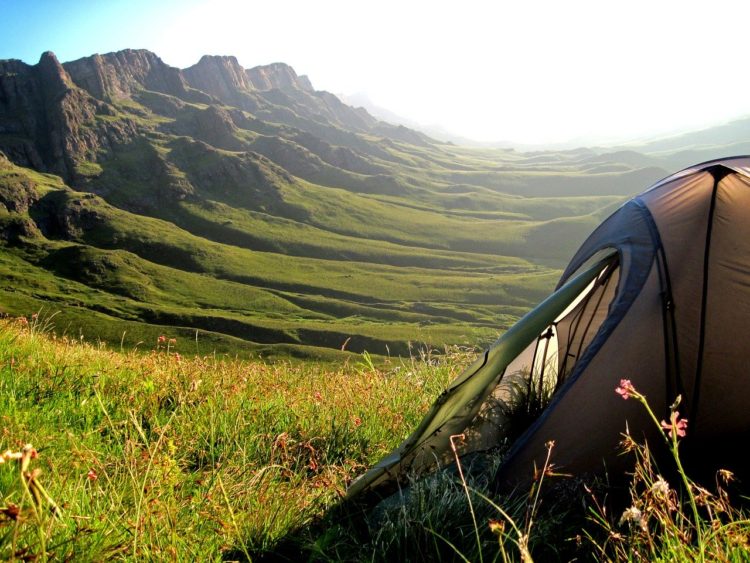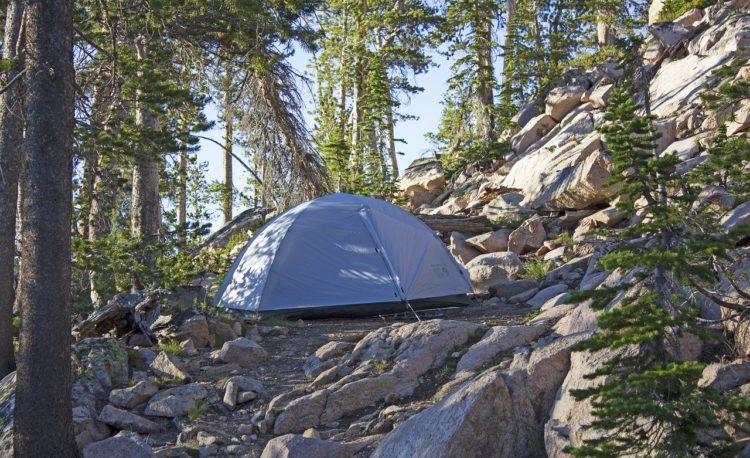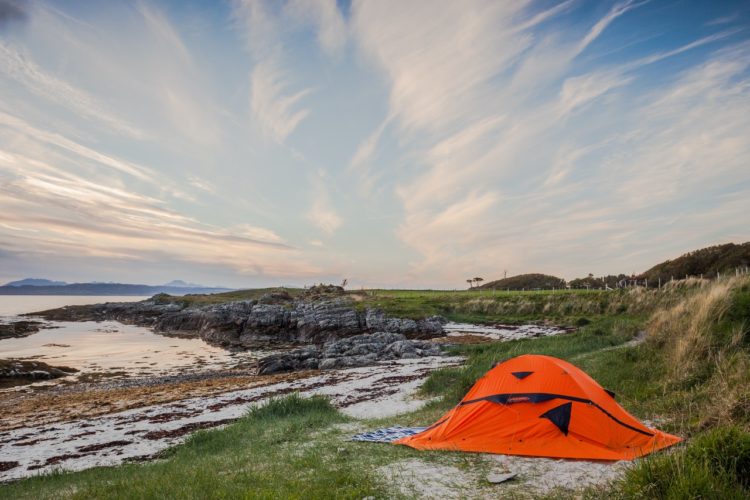If you’ve ever been camping, you’ve probably experienced the joys of tent stakes either stubbornly refusing to enter the ground, or equally stubbornly refusing to stay in it.
Sticking tent stakes in rocky ground is never easy, but picking the right style stake and using a few tricks can help make it less difficult. There are also several workarounds you can resort to when all stakes fail.
Table of Contents
Why Do you Stake a Tent?
Staking for Structure (Now Uncommon)
Tents have come a long way in the last 60 years.
As recently as the Vietnam War, the US army issued canvas pup tents to soldiers.
These were not the sleek freestanding mesh and nylon tents of today, pup tents consist of two canvas halves, two telescoping steel poles, and a pair of guy ropes.
The bottom edge of each half is staked down to the ground, with the upper edge stuck onto the tops of the poles in a tippy, rickety configuration. It takes the tension of the guy lines being staked out in front of the ends to hold the tent upright.
Ultralight backpackers still use a similar system, like this GEERTOP 2-Person tent, with telescoping trekking poles taking the place of those heavy steel poles, and one-piece nylon replacing the two canvas pieces.
Staking Adds Space and Water Resistance
Fabric sags, so to create a livable space inside, a tent needs to be put under tension. The more tension, the less it will sag, but we don’t want to tear the fabric either. Sag not only robs your livable space, it also makes tents leak.
Tent fabrics are water-resistant, not waterproof. Waterproof fabrics don’t breathe well enough to make good shelters. Button down a waterproof tent and you’ll suffocate. Water-resistant materials will leak if water is allowed to pool on them.
Modern tent designs have advanced to carefully balance bending flexible tent poles within stitched sleeves with the tension they impart on the fabric of the tent walls and floor. Some manufacturers have even done away with poles entirely in favor of inflatable air tubes.
Ultralight enthusiasts don’t use any structure, instead they rely on ropes to pull tension up as well as down.
No matter what your tent uses for structure, it doesn’t provide enough tension by itself. Tents are designed to gain extra tension by staking down. For many rectangular tents, that means staking at the corners for basic weather, and pulling out additional guy lines when expecting harsher weather.
Wind Resistance
In high winds, stakes also help hold the tent in place. Even with sleeping gear set up inside, a tent can lift off in high enough winds.
Many mornings after camp-outs at the summer camp I grew up working at, we would tear down tents that were still wet with morning dew in order to hike back to the Lodge in time for breakfast.
After breakfast, we’d set the tents up in a hurry out in the sports field to dry out. In the hurry to get on with our day, sometimes the tents didn’t get staked down.
One morning in particular, a few tents blew into the nearby lake and ended up much wetter than they started.
Do you Have to Stake Your Tent?
I always stake my tent.
I also always use my rain fly.
I live in Wisconsin, an area that has whole-heartedly adopted the saying “If you don’t like the weather, wait five minutes, it’ll change.”
That’s more than a it of an exaggeration, but our weather does turn quickly enough that I don’t trust a calm evening to tell me much of anything about the night and early morning to come.
Tent stakes serve to hold a tent in place in the wind, and help the tent shed water. They also keep the tent from sagging, giving you more space to move around in.
If your tent has enough room without the added space that tension can give you, and the weather is going to stay clear, you could choose to forego your stakes.
Just keep in mind that absorbent materials like bedding and pillows will wick water through the tent walls if you get a heavy dew drop in the night, so you do need to have enough space to not touch the walls.
What are the Best Tent Stakes?
The best tent stakes depend on the situation. Different styles suit different ground types.
The thin (1/8′ diameter or so), bent aluminum rods that come with most tents are fine for moderate ground. They won’t hold well in snow, sand, or loose gravel. And many people hate them because they bend very easily when they meet with rocks, roots, or anything else hard.
Bent aluminum rod stakes are a lightweight option, and work great for woodland camping in my area. But if you don’t mind a little extra weight, the same design is available in galvanized steel. Steel is three times as stiff as aluminum, and much cheaper, but it also weighs three times as much.
In harder materials, opting for a thicker nail-shaped stake works best. Galvanized barn nails from the hardware store work great, and they come in a variety of lengths. Purpose-made products like these are also available, with plastic flanges molded onto the nail just below the head.
Softer materials like snow, sand, and loose gravel work best with finned designs. For an upscale option, try the MSR Groundhog, or opt for some plastic stakes if you want to stay cheaper. The increased surface area really helps stick those stakes in place.
Basics of Tent Staking in Easy Spots

The main thing to remember when staking is to set your stakes is to jump to alternate corners of the tent. Also, don’t set your stakes until you’ve erected your tent. Having a tent staked to the ground while trying to put in the poles is no fun at all. If you’re fighting winds while setting, you might want to set one stake to hold everything in place first.
Drive stakes all the way in, leaving just enough sticking up to be able to pull them back out when you break camp. The more stake sticking out of the ground, the more likely high winds will bend your stake, or pry it out of the ground. You also sacrifice holding power in the ground itself when you don’t use the full length of the stake.
Don’t pound tent stakes. With the exception of the heavy-duty nail-style stakes used in very hard ground, little camping tent stakes just can’t take that kind of beating.
If the stake hits a rock or root, move it a bit, or tilt it, and try again. You might get particularly unlucky with a large subsurface rock and end up repositioning your whole tent to get a good staking out, but pounding won’t put a flimsy aluminum rod through a large rock anyway.
For a rectangular tent, set one stake, then go to the opposite corner, pull the stake loop out away from the tent until you have not only the loop, but also the tent floor itself taut, and set the next stake to hold the tension. Repeat this tension and staking on the remaining corners.
Other shapes can get a bit trickier, but the goal is to pull a good uniform tension across the tent floor when you stake it out.
Contrary to popular belief, you want your tent stakes vertical, or nearly so.
Many of us learned that you need to obey the “90 degree rule”, keeping your stake at right angles to guy lines. I learned that you imagine your tent upside-down in the earth, and aim for the top of it.
It turns out neither of those is very correct.
Studies on exact pullout capacity of tent stakes are tough to do, as so much of that capacity depends on the soil you stick your stakes in.
In fact, according to the Pullout Capacity of Tent Stakes – Pocket Guide, a pamphlet written for large panel tent companies, a stake in “Hard” ground will have about 25 times the holding power of stakes set in “Very Soft” ground.
But the pamphlet does underscore the importance of driving stakes near-vertically into the ground, and provide us good information backing up how different soil types and rock content can change holding power.
Staking on Hard, Rocky Surfaces

Use the right stakes: heavy-duty steel spikes with nail heads on the end. I wouldn’t go thinner than 1/4″ diameter for the body of the spike itself.
The good news is you don’t need these super long if you’re in really hard ground, so they’ll only weigh a little more than ordinary aluminum stakes.
But if you’re car camping on compacted ground of uncertain quality, do yourself a favor and bring a few different lengths. Go to the hardware store and grab some 4″, 6″, and 8″ barn nails, it’ll still be cheaper than fancy tent stakes.
This is the only situation where pounding is okay.
If you can, pour some water (or other liquid) on the hard ground you intend to ram heavy spikes into. That water will seep in and lubricate the space between the grains of soil and rock, helping your spike enter.
This takes some time, so you might need to take a break and make some coffee while you wait.
Once the ground is softened up, grab a hammer, mallet, back of your hatchet, log, or large rock, and pound away.
Be careful not to hit your tent with a rough rock while you’re pounding.
Consider bringing some small lengths of paracord to tie onto your stakes and loop through your tent grommets or stake loops to add some distance if you’re at all concerned about damaging your tent.
Staking on Soft Sand and Snow

As usual, bring the right stakes for the job is the best advice I can give here. Longer, fin-style stakes are ideal for loose soil, gravel, and snow.
If you didn’t bring long stakes, you can substitute long, straight sticks. They may be tough to drive, so you have permission here again to pound.
Sharpen the tip going into the ground, and chamfer the top end of the stick before pounding to prevent splintering.
In shallow snow over hard ground or ice, you can bury objects to get a better hold.
Tie one end of a line to the grommet or stake loop, and the other to something you can bury, like a long stick, or a pine bough. Dig a trench, set the anchor down in it, and cover it back up.
When Stakes Don’t Work
If you’re pitching your tent on a parking lot, boat deck, or anything else you just can’t stake to, use anchors instead.
Car camping, just bring some rocks or weights to set on lines coming off your stake loop on your tent. You can run a long line out and pile weights all along the length if needed.
Backpacking, you’re unlikely to have an ample supply of weights along. You’ll have to get creative and resort to anything that might work.
Some ideas for improvised anchors:
- Water bottles
- Pots filled with water, gravel, or rocks
- Dry bags filled with water
- Canoe
Given the option, tie down to anything solid, like a tree, root, log, or large rock.
Remember, the biggest help in staking tents is having the right kind of stake for the terrain. If you have the option (like tent camping), bring a variety of tent stakes along to ensure you have something that will work well.
Even if you’re careful, tent stakes do break or get lost from time to time. So make sure you’re well-stocked with appropriate stakes for whatever soil types you expect to encounter before your next trip:
- Best All-around Soft Ground (sand, snow, gravel) Stakes: MSR Groundhog
- Best Stakes for Sand and Snow: MSR Blizzard
- Best Lightweight Stakes for Normal Ground: Hikemax Titanium
- Best Stakes for Hard Ground: Eurmax Galvanized 10″
And if you’re looking for more camping tips, don’t miss my Get Started Camping article, which includes fully priced-out gears lists for beginner and intermediate level campers, critical skills, and a map of 307 top-rated campground across the US.



